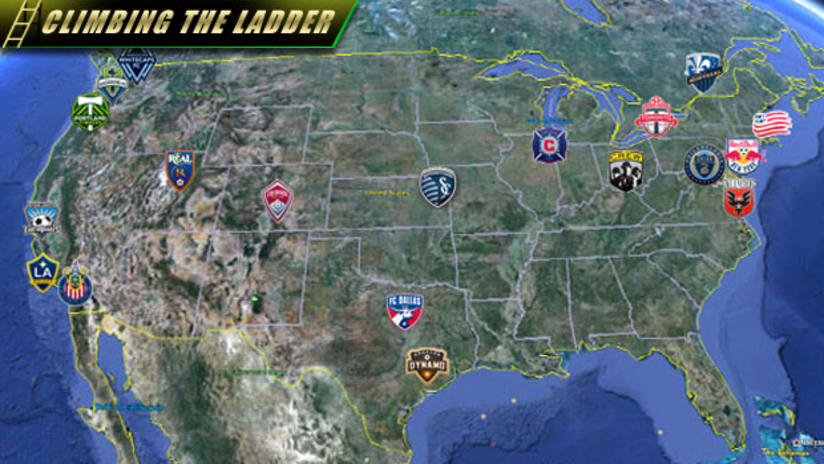A decade after contraction, the 2012 Major League Soccer season will begin next month with nearly twice as many teams as it did in 2002. Back then, the mood wasn’t quite as optimistic. A 19-team league seemed like a dream when the number had just gone down to 10, which was back to square one.
The mood was one of survival and consolidation. Happily though, MLS has grown by leaps and bounds since then. Expansion has occurred at a furious pace, and that’s brought plenty of passion as well as new fans. Now, more Americans than ever before have an MLS team of their very own to support.
| Percentage of Americans in MLS markets | ||||
| Year | US teams | MLS Markets | % of US pop. | |
| 1996 | 10 | 63,937,384 | 25.7 | |
| 1997 | 10 | 63,937,384 | 25.7 | |
| 1998 | 12 | 76,378,756 | 30.7 | |
| 1999 | 12 | 76,378,756 | 30.7 | |
| 2000 | 12 | 88,269,391 | 31.4 | |
| 2001 | 12 | 88,269,391 | 31.4 | |
| 2002 | 10 | 80,865,830 | 28.7 | |
| 2003 | 10 | 80,865,830 | 28.7 | |
| 2004 | 10 | 80,865,830 | 28.7 | |
| 2005 | 12 | 82,335,304 | 29.3 | |
| 2006 | 12 | 80,057,830 | 28.4 | |
| 2007 | 12 | 80,057,830 | 28.4 | |
| 2008 | 13 | 87,150,426 | 31.0 | |
| 2009 | 14 | 90,857,570 | 32.3 | |
| 2010 | 15 | 105,895,261 | 34.3 | |
| 2011 | 16 | 108,121,270 | 35.0 | |
| 2012 | 16 | 108,121,270 | 35.0 | |
How many Americans have a potential team to cheer on these days? Using the populations from the past three United States censuses, it’s easy to measure that growth. The number of people in each team’s market can be determined using the government’s data for Primary Statistical Census Areas. Those definitions take into account the number of people living in the entire area, not just the main city.
Starting in 1996, the 10 original markets represented 25.7 percent of the total population at the time. It could’ve been higher if Chicago had been one of the first teams, which they were when plans for the league were originally announced in November 1994. At that point, a Long Island team was also in the plans. Eventually, Colorado, Dallas and Kansas City were given the last three spots in the league, and Chicago was dropped until 1998.
Just before contraction, the percentage had risen to 31.4 percent, which was the high point until recently. The biggest change then came from 2008 to 2011, when one new American team was added per year. In 2007, 28.4 percent of Americans had an MLS team in their market. Today, that number has risen to just over 35 percent. That’s a difference of 6.6 percent, and it amounts to more than 28 million additional people.
So if it seems like more folks are paying attention, that might be a big reason why. MLS now has teams in nine of the top 10 markets (Atlanta is the final holdout), though with only 11 of the top 20, there is still room to grow.
MLS is not just an American league, either, as some of the biggest expansion successes have come north of the border. The growth in Canada has been of the best things to happen to the league in recent years, and three new Canadian clubs in six years means that the percentage of citizens there who have a potential team is now comparable to the US.
Toronto, Montreal and Vancouver are the three largest markets in Canada respectively. Together, they represent 34.4 percent of the country, or just about the same percentage the American MLS markets hold. Montreal, as the second-largest market, should be a good addition. With a metro population of more than 3.6 million people, it’s larger than the next three MLS-less areas combined: Ottawa, Calgary and Edmonton.
| Percentage of Total Market Presence | ||||
| USA | Canada | Total | ||
| MLS | 35.02 | 34.37 | 34.96 | |
| MLB | 46.74 | 16.17 | 43.90 | |
| NBA | 46.75 | 16.17 | 43.91 | |
| NFL | 43.70 | 0.00 | 39.64 | |
| NHL | 39.88 | 46.83 | 40.53 | |
MLS markets make up a combined total of 34.96 percent of the American and Canadian populations. How does that compare to the other major sports leagues?
The NFL is the only league not in Canada, though the Buffalo Bills have made Toronto something of a second home. As a result, they end up fourth when both countries are combined. However, that placement is due entirely to the lack of a Los Angeles-area team. With a franchise in LA, they’d be in first.
The NBA ends up just slightly ahead of MLB by a margin of only 49,609 people. That comes despite the fact that baseball has teams in each of the top 19 markets, the only league to do so. That’s because several baseball markets have multiple teams, which means that there are more basketball markets overall.
Overall, there are fewer than nine percentage points separating MLS from all four of the other leagues. That’s impressive, as it comes despite each of them having at least 30 teams. While market size is not everything, and it certainly doesn’t equal success, it is important. It’s getting harder and harder to go to a major metropolitan area and not run into an MLS team, and that’s a sign of progress.












